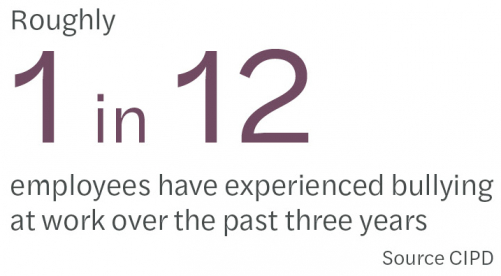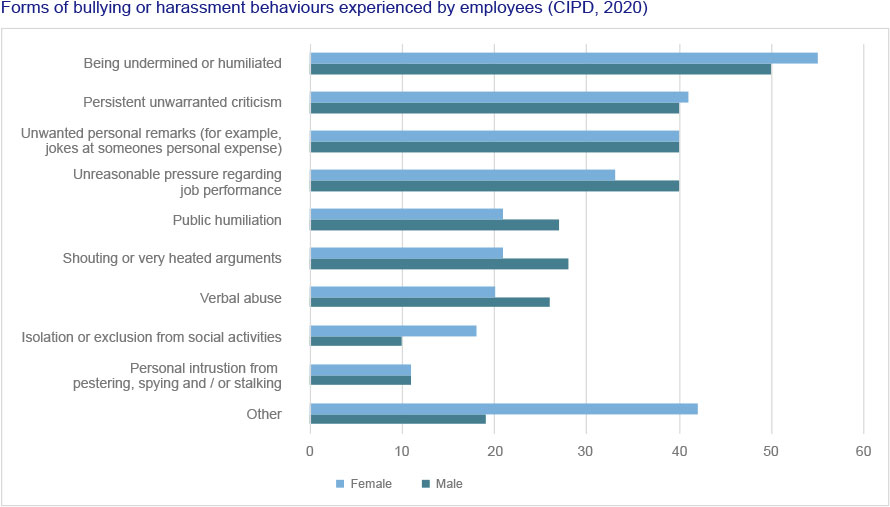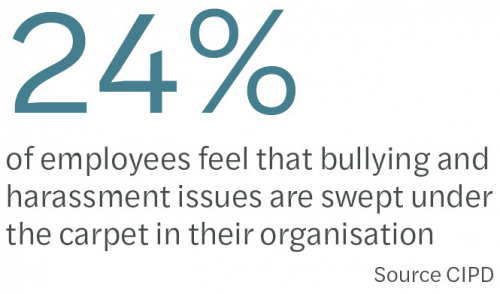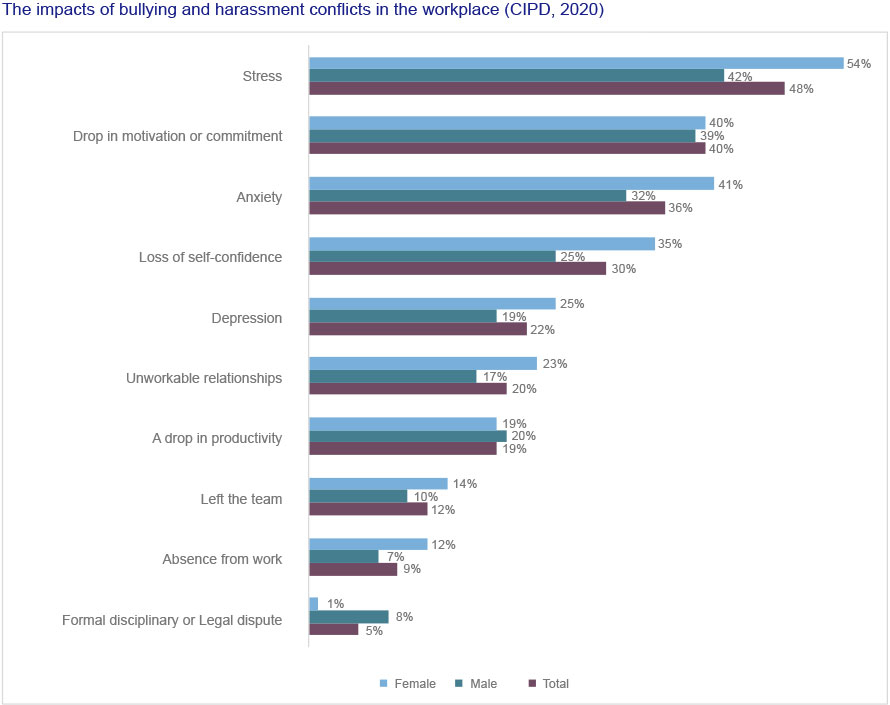
Bullying and harassment in the workplace
Bullying and harassment in the workplace
Indeed, there have been several recent high profile cases resulting in significant penalties for the organisations involved.
A very real problem
The most talked-about example in the Public Sector is perhaps the recent investigation into the conduct of the Home Secretary, which resulted in a costly £340,000 settlement pay-out and ongoing public scrutiny.
Further afield, we have seen a whistleblowing report raise allegations of a ‘toxic culture of bullying and harassment at the government-owned Sellafield nuclear site, leading to concerns about the knock-on impact on nuclear safety at the site and several grievances being made against the company by current and ex-employees.
Private Sector companies are no less susceptible. In late 2020, Talbot Underwriting, (a Lloyds of London Insurance and Reinsurance Specialist) was forced to make a financial settlement with a former employee after a tribunal found that the employee had been bullied. this included being subjected to a beratement lasting 4 minutes by a senior manager in front of colleagues, which led to a decline in the employee’s mental health and eventual resignation.
We have also recently seen two senior leaders at Imperial College London face calls to resign and issue public apologies for bullying after a series of whistleblowing complaints led to an independent inquiry and, disciplinary hearings.
There is therefore a clear business need to prevent and manage incidents of bullying and harassment effectively. The consequences for individuals and the wider entity can be extremely damaging. Employees’ performance and efficiency may be adversely affected by a bullying or harassment incident and could potentially lead to non-compliance with policies and procedures or even breaches of controls.
Business leaders and their organisations are coming under increasing media and public scrutiny when they have allowed unacceptable behaviour to occur within their organisation. And, there are significant financial and reputation damages when they get it wrong.
Identifying bullying in the workplace
There are no set criteria to define what behaviour amounts to bullying and what does not, as there are many factors at play. The common denominator is the impact on the victim. It may therefore be appropriate to first assess any alleged behaviour from the perspective of the individual on the receiving end.
For instance, when you introduce authority to a scenario, whether perceived or actual authority, actions and words from one individual to another may carry more weight. What may be considered acceptable or may be able to be brushed off by one individual may have a significant impact on another. It is most often these grey areas that cause episodes of workplace conflicts rather than extreme cases of bullying.
The Advisory, Conciliation and Arbitration Service (ACAS) provides examples of unacceptable behaviour in the workplace, some of which include:
- Unfair treatment
- Deliberately undermining a competent worker by overloading and/or constant criticism
- Setting an individual up to fail
- Ridiculing or demeaning someone, particularly in sight of other employees and senior personnel
- Overbearing supervision or other misuses of power or position
- Preventing individuals from progressing, whether this be direct as an appraiser by blocking promotions or denying development opportunities, or indirectly through raising complaints or negative feedback to an individual’s appraiser
- Making threats or comments about job security without foundation
Often in a workforce made up of intelligent and competent people, bullying behaviours will be difficult to spot. They may develop in a gradual, subtle way but with very harmful effects if not identified and dealt with swiftly.
Perpetrators can often be clever in concealing their misconduct by treading ‘on the right side of the line’ in view of others, with the most destructive of bullies maintaining a certain façade – particularly in front of persons with authority – as a means to prevent suspicion. When this happens, the likelihood of the victim reporting the behaviour can be much lower, as they may feel they will not be believed given the way their bully may be perceived by their colleagues.
It is therefore vital that business leaders communicate a clear message within their organisation that any employee will be given the time to be heard, and vital that they remain objective when any allegations are made.
This issue extends beyond the sphere of the perpetrator and victim too. Other employees may be reluctant to challenge unacceptable behaviour in fear of being subject to it themselves or may become complicit with the bully in an act of defence. When a bully manages to establish such a position, colleagues may appear to the victim as bystanders or as bullies themselves, which can leave a victim feeling impossibly alone within an environment that should be supporting them.
An organisation must put safeguards in place to reduce the risk of an episode of bullying or harassment related conflicts ever reaching this point.
Identifying harassment in the workplace
Harassment is viewed as more serious misconduct than bullying and can constitute a criminal offence on behalf of the perpetrator. Employers may also be liable for the actions of their employees in the workplace.
The Equality Act 2010 defines harassment as:
“Unwanted conduct related to a relevant protected characteristic, which has the purpose or effect of violating an individual’s dignity or creating an intimidating, hostile, degrading, humiliating or offensive environment for that individual”
It is crucial to understand from this definition that behaviour can amount to harassment even if that was not how it was intended (the same can be true for bullying behaviours too).
A 2020 report by the Equality and Human Rights Commission (EHRC) summarises the three types of harassment made unlawful by the Equality Act, which are:
- Harassment related to a ‘protected characteristic’
- Sexual harassment
- Less favourable treatment of a worker because they submit to or reject sexual harassment or harassment related to sex or gender reassignment.
Where the protected characteristics listed in the Equality Act include:
- Age
- Disability
- Gender or gender reassignment
- Race
- Religion or beliefs
- Sexual orientation
Where a harassment incident occurs within an organisation, an employer could be held liable unless they can prove they took all reasonable steps to try to prevent the behaviour. Not doing so may expose an organisation to liability and hefty fines. In December 2020, the Department for Work and Pensions was ordered to pay more than £370,000 to an ex-employee after being held liable for discriminatory behaviour carried out by staff.
Guidance from ACAS says that an employer may be held vicariously liable for harassment by an employee if the perpetrator was acting ‘in the course of their employment.
Crucially, the scope of ‘in the course of their employment’ extends beyond the office and includes employee activity at social events and on social media where the organisation may have less control over, or sight of, the conduct of their employees.
It is also vital to understand that such liability can arise even when management is unaware of the harassment behaviours taking place, as it is the responsibility of the organisation to put in preventative measures to minimise the risk of incidents occurring in the first place. The need to take all reasonable steps to prevent such behaviour, therefore, becomes a critical need.
The consequences of getting it wrong
The consequences of a bullying and harassment incident can be devastating for an individual, but may also impact the wider organisation and cause significant damage, whether this is financial, reputational or legal/regulatory.
Exposure to bullying or harassment at work can destroy an individual's confidence and ability to perform, and might impact how that individual interacts with other employees within the organisation.
A CIPD survey on the impacts of bullying and harassment in the workplace found that 20% of respondents felt that relationships with certain colleagues at work had become untenable due to the conflict they had experienced.
In some investigations we have conducted in the past, we have seen how devastating the knock-on effects can be for an organisation; where vital procedures or internal controls were bypassed or improperly performed as a result of damaged relationships, inhibiting communication between individuals.
Malperformance of control activities in any context may put an organisation at increased risk of fraud, non-compliance and other potential criminal activity. It is therefore vital that business leaders consider the risk that any activities involving people with a conflict may have been vulnerable to mal performance, and investigate whether their organisation may be subject to potential financial loss or regulatory scrutiny as a result.
The consequences of mishandling a bullying and harassment incident may hit closer to home than expected for some business leaders, who are increasingly coming under fire for any mishandling of bullying and harassment complaints.
We have conducted investigations in the past year where evidence has shown that allegations of bullying and harassment within organisations were received by senior personnel but not acted upon appropriately. There were two cases where the senior persons were themselves held partially responsible by their employers for the fallout of the bullying incident and ultimately parted ways with their organisation.
Employment tribunals are starting to see things the same way too. In January 2021, Royal Mail was instructed by a Cardiff employment tribunal to make a payment of £230,000 to a former employee after letters of complaints were ignored by managers, despite follow-up requests for an independent inquiry to be undertaken.
There is therefore a critical business need for action to be taken in respect of any bullying or harassment incident. We are seeing penalties issued and losses incurred by organisations who get it wrong, so the million-pound question is: “how to get it right?”
What business leaders can do
The appropriate action for a bullying and harassment incident will depend on how evolved the incident has become.
Preventative action
Effective training as to what behaviours constitute bullying or harassment and a clear, communicated zero-tolerance policy (backed up by actions where necessary) will contribute to an inclusive workplace culture that will reduce the likelihood of a conflict arising.
The organisation should have in place the proper mechanisms to manage cases of unacceptable behaviour, such as an appropriate whistleblowing policy and complaints procedure operated by appropriately trained persons.
An organisation should also be keeping a record of the preventative measures they have implemented and should continuously reassess whether these remain effective. By doing this they may be able to prove that they have taken all reasonable steps to prevent a harassment incident from occurring and therefore rely on the ‘reasonable steps’ defence to protect itself from the liability of the potential action of harassment by one of its employees.
Responsive action
If an ongoing incident does emerge, an organisation should have effective procedures in place that place priority on addressing unacceptable behaviours and addressing conflicts.
It is essential allegations are taken seriously and inquiries are given the necessary resources to be undertaken effectively, with remedial action delivered promptly to reduce the risk of any lasting damage within the workforce.
Retrospective action
Where a bullying and harassment incident has evolved to such an extent that an organisation has suffered loss, leaders must be seen to take action. There are many considerations as to what types of action to take and how these actions should be executed. After all, these cases can be extremely emotionally, commercially and politically sensitive and the next steps must be careful and calculated.
One option is to conduct an investigation in-house, which can be the cheaper option but may also be vulnerable to internal politics and other bias. For example, certain conduct or actions may be considered to be ‘normal’ by an employee of the firm and could be overlooked. An internal investigator may also themselves be subject to influence from within, particularly if the alleged perpetrators are of a senior position, are familiar to them or carry a certain reputation.
This raises an important decision for business leaders. Should the investigation be handled internally or externally?
The power of an external investigator
An external investigator can offer the independence, and objectivity to enable appropriate inquiries to be made and conclusions reached free of any obstructions to which an internal party may be exposed, in particular when a whistleblower is involved.
External advisers also bring experience and expertise in conducting investigations, which adds credibility and weight to a process and its findings. They are also more likely to have the staff and connections to resource large investigations.
For matters concerning bullying and harassment - particularly those concerning senior personnel in positions of power - engaging an external, independent investigator helps show that the investigation into the allegations and conduct has been impartial and procedurally fair.
For organisations operating in regulated environments, external experts can also provide aid in the navigation of any intricate legal and regulatory issues they may need to consider in light of the findings of an investigation. Including obligations to report findings and, how best to retain control over commercially sensitive evidence should a regulator come knocking.
Mazars investigations and compliance
Mazars has a proven track record of undertaking large and complex investigations and compliance projects across a broad range of sectors both nationally and internationally, with significant experience in managing investigations involving commercially and politically sensitive allegations of bullying and harassment.
Our partner-led teams combine qualified accountants and fraud examiners with computer forensics. These enable us to execute detailed investigative procedures such as the study of documents and review of email inboxes thoroughly and efficiently, and provide a bespoke, technology-driven service to our clients. We have extensive experience of being able to present complex financial information and other evidence in a manner that can be easily understood, and focus on presenting the facts.
If you would like to understand our case experience and credentials in more detail or would like to have a conversation relating to any matters your organisation may be facing, please find our contact details on the next page.





